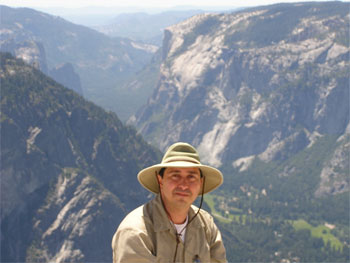Research and Sponsored Programs
Dr. Alejandro Calderón-Urrea wins - 2005 Claude C. Laval Jr. Award
FRESNO, Calif. (June 10, 2005) -- Dr. Alejandro Calderón-Urrea, an Associate Professor in the Department of Biology, has been selected as this year’s recipient of the Claude Laval, Jr. Award for Innovative Technology and Research for his proposal, "Use of 4D microscopy to study early development in the plant parasitic nematode Meloidogyne incognita."
The Laval Award is administered through the University’s Office of Research and Sponsored Programs. Established in 1984 in honor of Claude C. Laval Jr., a long-time resident of Fresno and a productive inventor, the award has supported the development of innovative technology and related research at Fresno State. Funding is provided by a gift to the university from Mr. and Mrs. Claude C. Laval III.

Dr. Calderón-Urrea obtained his Bachelor of Science from Universidad del Valle and his Ph. D. from Yale University. His postdoctoral work focused on understanding the molecular mechanisms involved during plant-pathogen interaction. Dr. Calderón-Urrea joined the faculty of the Biology Department at Fresno State in the fall of 1997.
The primary focus of Dr. Calderón-Urrea’s research at Fresno State is to understand the process of programmed cell death in plants, and in particular to use programmed cell death to protect plants against parasitic nematodes. A major problem facing agricultural production in the San Joaquin Valley in California, as well as other agricultural centers of the world, is the management of nematode pests. Parasitic plant nematodes result in an estimated $10 billion a year loss to U.S. agriculture, and nearly $100 billion loss worldwide.
Economic loss is not the only problem associated with plant pathogenic nematodes. The best defense against nematode pests is the use of methyl bromide, a chemical of great environmental hazard scheduled to be phased-out from U.S. agriculture. Hence new approaches to control nematode pests that are both effective and environmentally friendly are urgently needed. A larger project in Dr. Calderón-Urrea’s laboratory, funded by ARI-CATI, addresses the possibility to use nematode cell suicide genes in transgenic plants as a mechanism to control nematode infestation.
A complementary objective to this project is the description of early stages of development in plant parasitic nematodes; knowledge of early stages of development will allow Calderón-Urrea to detect stages at which parasitic nematodes are most vulnerable to the action of cell death genes. The use of 4D microscopy has allowed the understanding of early stages of development of many model organisms. Four-D microscopy is defined as the method by which pictures of several focal planes of an object can be generated at given time intervals. If the object is a developing nematode embryo, and enough time is allowed until the embryo has developed completely, 4D microscopy would allow the generation of the cell lineage of the nematode.
The Claude Laval, Jr. Award for Innovative Technology and Research is providing the funds to support this important aspect of Calderón-Urrea’s research. In particular, funds will be used to accomplish the following specific objectives: 1) to set up 4D microscopy at Fresno State; and 2) to use 4D microscopy to describe early development of the plant parasitic nematode Meloidogyne incognita.
For more information, contact Doug Carey in the Office of Research and Sponsored Programs, 278-0856.